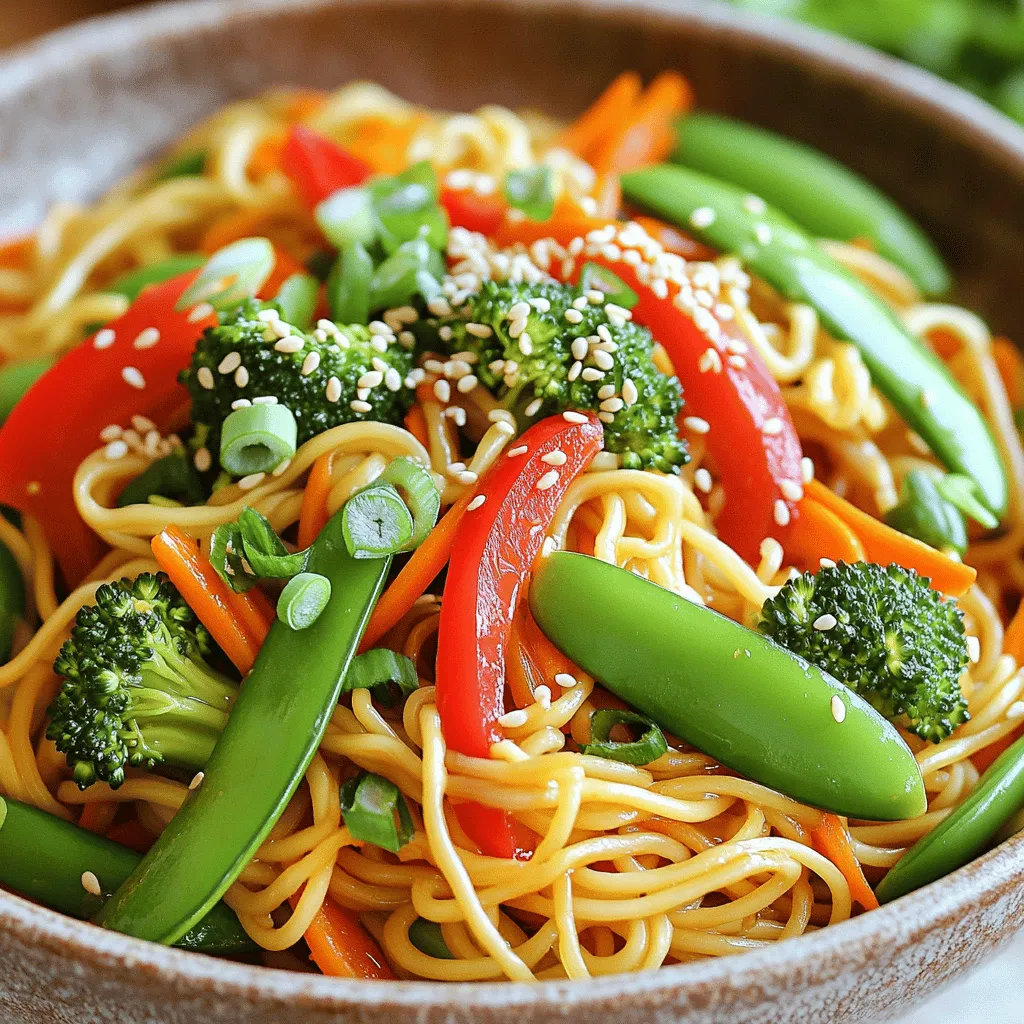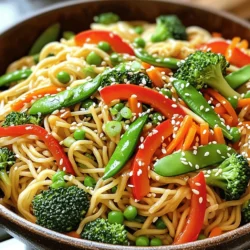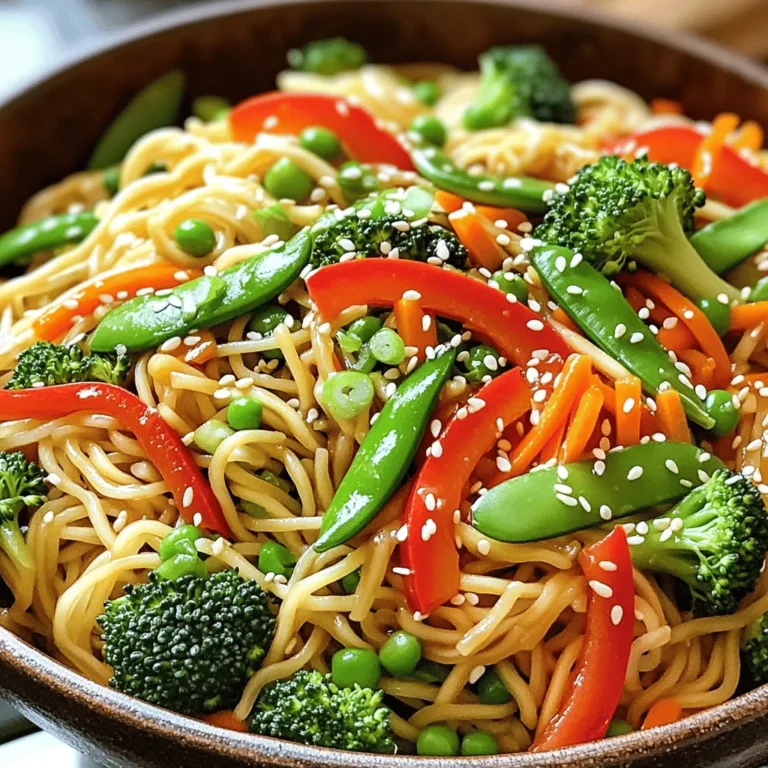Looking for a quick, tasty dinner idea? Vegetable Lo Mein is your answer! This colorful dish combines fresh veggies with savory noodles for a delightful meal in just 30 minutes. Whether you’re busy during the week or want to impress guests, this recipe is both simple and satisfying. Let’s dive into the flavorful world of Vegetable Lo Mein and learn how to whip up this easy weeknight staple that everyone will love!
Ingredients
Essential Ingredients for Vegetable Lo Mein
– 8 oz lo mein noodles
– 2 tablespoons vegetable oil
– 1 red bell pepper, sliced
– 1 cup broccoli florets
– 1 cup snap peas
– 1 carrot, julienned
– 2 green onions, chopped
– 3 cloves garlic, minced
– 1 inch ginger, grated
– 3 tablespoons soy sauce
– 1 tablespoon sesame oil
– 1 tablespoon hoisin sauce
– Salt and pepper to taste
– Sesame seeds for garnish
These ingredients make a great base for your Vegetable Lo Mein. Each one plays a key role in building flavor and texture. The lo mein noodles give the dish its heartiness. They soak up the sauces very well.
The fresh vegetables add color and crunch. Red bell pepper and broccoli are my favorites. They not only taste great but also look beautiful on the plate. Garlic and ginger give the meal a fragrant kick. Soy sauce, sesame oil, and hoisin sauce bring depth and richness.
Optional Ingredients for Customization
– Additional vegetables (e.g., mushrooms, baby corn)
– Protein options (e.g., tofu, shrimp, chicken)
– Alternative sauces (e.g., oyster sauce, chili garlic sauce)
You can customize your Vegetable Lo Mein. Toss in extra veggies like mushrooms or baby corn. If you want protein, tofu, shrimp, or chicken work well. You can also switch up the sauces. Try oyster sauce for a richer taste or chili garlic sauce for heat.
Step-by-Step Instructions
How to Prepare Your Vegetable Lo Mein
– Step 1: Cook the Noodles
Start by boiling a pot of water. Cook the lo mein noodles as the package says. Once done, drain them and toss with a bit of vegetable oil. This keeps them from sticking.
– Step 2: Sauté the Vegetables
Heat vegetable oil in a large skillet or wok over medium-high heat. Add minced garlic and grated ginger. Sauté for about 30 seconds until you smell that amazing aroma.
– Step 3: Combine Ingredients
Now, toss in sliced red bell pepper, broccoli florets, snap peas, and julienned carrot. Stir-fry these veggies for 5 to 7 minutes. You want them tender but still crisp.
– Step 4: Finish and Serve
Add your cooked noodles to the skillet with the veggies. Pour in soy sauce, sesame oil, and hoisin sauce. Mix well for 2 to 3 minutes until the noodles are coated in the sauce.
– Step 5: Garnish
Stir in chopped green onions and season with salt and pepper to your taste. Give everything a good toss. Then, transfer to a serving dish and sprinkle sesame seeds on top for a nice crunch.
Cooking Tips for Perfect Noodles and Vegetables
– Avoid overcooking the noodles: Make sure you follow the cooking time. Overcooked noodles can turn mushy and lose their bite.
– Maintain vibrant colors in the vegetables: Quick cooking keeps your vegetables bright and crunchy. This not only looks good but tastes fresh too.
– How to achieve the right stir-fry consistency: Keep your heat high and stir often. This ensures even cooking and prevents burning.
Tips & Tricks
Key Tips to Enhance Flavor
– Using fresh ingredients vs. frozen: Fresh veggies make a big difference. They are crisp and full of flavor. Frozen veggies can work, but they might lose some texture. I recommend using fresh if you can.
– The importance of proper heat: Heat is key to cooking lo mein well. Use high heat to stir-fry quickly. This keeps the vegetables crisp and bright. If the heat is too low, they can become soggy.
– Balancing flavors with salty, sweet, and umami: Good flavor comes from balance. Use soy sauce for saltiness, hoisin for sweetness, and sesame oil for umami. Experiment with the amounts to find what you love.
Troubleshooting Common Issues
– Fixing mushy noodles: If your noodles turn mushy, try cooking them less next time. They should be al dente when you drain them. Rinse with cold water to stop the cooking.
– Adjusting seasoning for personal preference: Taste as you cook. If it’s too salty, add a splash of water. If it needs more flavor, add a bit more soy sauce or hoisin.
– Ensuring ingredients are well-distributed: When tossing everything together, mix thoroughly. This ensures every bite has a good mix of noodles and veggies. Use tongs for better control.

Variations
Different Styles of Lo Mein
You can easily change up Vegetable Lo Mein to fit your needs. Here are some options:
– Vegetarian options and substitutions: If you want a meatless meal, stick with the basic recipe. Add more veggies like mushrooms or baby corn for extra flavor and texture. Tofu is a great protein source, too.
– Protein-packed versions with meat: For a heartier dish, add chicken, beef, or shrimp. Cook the meat first, then set it aside. Stir-fry your veggies, and add the cooked meat back in with the noodles.
– Gluten-free alternatives with rice noodles: If you need a gluten-free option, try rice noodles instead of lo mein noodles. They cook quickly and soak up flavors well. Just follow the package instructions for cooking times.
Flavor Variations
Spice up your Vegetable Lo Mein with these ideas:
– Spice it up: Adding heat with chili oil: If you like heat, drizzle some chili oil over your finished dish. It adds a kick without overpowering the other flavors.
– Sweet and savory combinations: Mix sweet and savory by adding a touch of brown sugar or honey. This creates a nice balance with the soy sauce.
– Infusing new flavors with different sauces: Don’t be afraid to experiment! Try using oyster sauce or chili garlic sauce in place of soy sauce. This can really change the taste and keep your meals exciting.
Use these tips to create your own version of Vegetable Lo Mein.
Storage Info
How to Store Leftover Vegetable Lo Mein
To keep your Vegetable Lo Mein fresh, refrigerate it right away. Place the leftovers in airtight containers. This helps prevent moisture loss and keeps flavors intact. I recommend eating it within 3 to 4 days for the best taste.
Reheating Tips
When you’re ready to enjoy your leftovers, choose safe reheating methods. You can use a microwave or stovetop. If using the microwave, cover the dish to trap steam. This keeps the noodles soft. For stovetop reheating, add a splash of water or sauce. This step helps prevent the noodles from drying out. Stir often until heated through. Enjoy your quick and tasty meal again!
FAQs
Common Questions About Vegetable Lo Mein
What is the difference between lo mein and chow mein?
Lo mein uses soft, boiled noodles. Chow mein uses crispy, fried noodles. Both are tasty but offer different textures.
Can I make Vegetable Lo Mein in advance?
Yes, you can prepare it a day ahead. Store it in the fridge. When ready, just reheat it.
How do I make Vegetable Lo Mein low-carb?
Swap lo mein noodles for zucchini noodles or shirataki noodles. This cuts carbs but keeps the flavor.
Additional Inquiries
What vegetables work best for Lo Mein?
I love using bell peppers, broccoli, and snap peas. You can also add carrots or bok choy for variety.
Can I use pre-cooked noodles?
Absolutely! Pre-cooked noodles save time. Just heat them in the skillet with vegetables and sauce.
How to adjust the recipe for larger servings?
Double the ingredients for bigger batches. Ensure your skillet is large enough to stir everything well.
Nutrition Information and Dietary Considerations
Nutritional benefits of the ingredients used
Vegetable Lo Mein is rich in vitamins from fresh vegetables. It’s a great way to get your daily veggies.
Suggestions for making it vegan or allergy-friendly
Use vegetable oil and soy sauce for vegan options. Check sauce labels for allergens like gluten.
Caloric content per serving of Vegetable Lo Mein
Each serving has about 350 calories. It’s a hearty meal without too many calories.
You now have a clear guide to making delicious Vegetable Lo Mein. We covered essential ingredients, step-by-step cooking instructions, and tips for flavor. You learned how to customize your dish with different veggies and proteins. Plus, we discussed storing leftovers and reheating them perfectly.
Whether you want a quick meal or something to impress guests, this recipe fits the bill. Enjoy creating your own tasty variations! Dive into the world of Vegetable Lo Mein, and let your taste buds celebrate.


